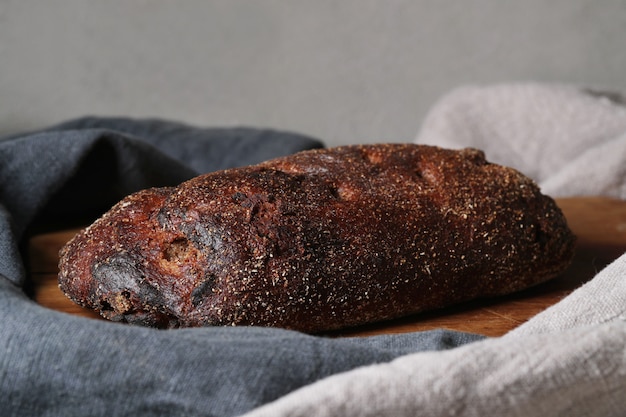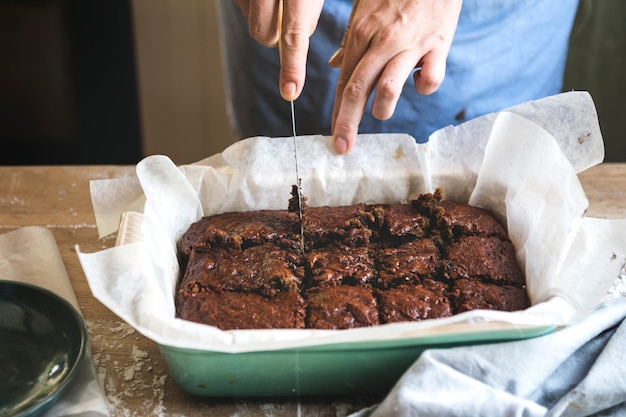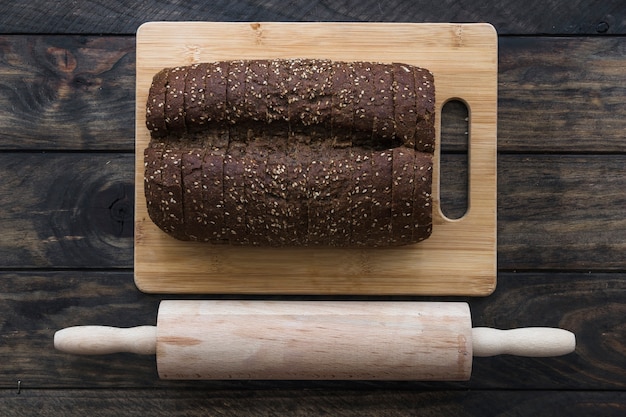Ah, meatloaf. The quintessential comfort food, a dish that evokes memories of Sunday dinners and family gatherings. But getting the cooking time just right is key. You want it perfectly cooked – juicy and flavorful, not dry and crumbly. Today, we're diving into the world of meatloaf, tackling the question of how long to bake a 1-pound loaf to perfection.
(Part 1) The Basics of Meatloaf: A Flavorful Foundation

Meatloaf, at its core, is a loaf of ground meat – usually beef, but often a blend of beef, pork, veal, or even lamb. It's bound together with breadcrumbs, onions, eggs, and a symphony of seasonings. But the beauty of meatloaf lies in its versatility. You can add so much more to it – chopped vegetables, cheese, herbs, even bacon! The possibilities are as boundless as your imagination.
The Importance of Oven Temperature: The Key to Even Cooking
Before we jump into the nitty-gritty of cooking times, let's talk about oven temperature – the unsung hero of meatloaf baking. It plays a vital role in ensuring your meatloaf cooks evenly. The general rule of thumb is 350°F (175°C). This temperature helps the meatloaf cook through without burning the outside. You can experiment with slight variations, but 350°F is a great starting point.
Why Oven Temperature Matters: Avoiding Mishaps
Why is oven temperature so crucial? Picture this: If it's too high, the outside of your meatloaf will brown and cook too quickly, leaving the inside raw. On the other hand, if it's too low, the meatloaf will take forever to cook through and might end up dry and tough. It's all about that sweet spot where the inside cooks thoroughly without overdoing the outside.
(Part 2) The 1-Pound Loaf Dilemma: Factors That Influence Cooking Time

So, you've got your 1-pound meatloaf ready to go, the oven is preheated, and you're excited to get cooking. But how long should you bake it? This is where things get a bit tricky. There's no universal answer. The cooking time depends on a few key factors:
- The size and shape of your loaf: A larger or flatter loaf will take longer to cook through than a smaller, more compact one.
- The type of meat you're using: Different meats have different cooking times. Beef tends to take a bit longer than pork, for example.
- How densely packed your loaf is: If you've packed your meatloaf tightly, it will take longer to cook than if it's more loosely packed.
General Guidelines: A Starting Point for Your Meatloaf Journey
Don't worry! There are some general guidelines to help you navigate the cooking time labyrinth. A 1-pound loaf of meatloaf typically takes about 45 to 60 minutes to cook through in a 350°F oven. However, it's always best to rely on a meat thermometer. The internal temperature should reach 160°F (71°C) for safe consumption – your guarantee of a perfectly cooked meatloaf.
The Resting Ritual: Letting the Meatloaf Relax for Juiciness
Here's a little secret: After baking your meatloaf, let it rest for about 10 minutes before slicing. This allows the juices to redistribute, resulting in a juicier, more tender loaf. It's all about that post-baking relaxation for a better-tasting final product.
(Part 3) The Art of Checking Doneness: Mastering Meatloaf Mastery

We've talked about the importance of a meat thermometer – your trusty sidekick in the meatloaf kitchen. But how do you use it? It's quite simple, really.
Using a Meat Thermometer: A Precise Approach
Insert the thermometer into the thickest part of the meatloaf, making sure it doesn't touch any bones or the pan. You want a reading of the internal temperature, and remember, 160°F (71°C) is the magic number for a perfectly cooked meatloaf.
Other Signs of Doneness: A Visual and Tactile Guide
Of course, there are other clues besides the meat thermometer. A cooked meatloaf should be firm to the touch, and the juices should run clear when you poke it with a fork. The outside should also be nicely browned, signaling that the meatloaf has reached its peak.
What to Do if It's Not Done Yet: Adjust and Re-Bake
If your meatloaf isn't quite cooked through, don't panic! Just pop it back in the oven for a few more minutes. But keep a close eye on it, as it can quickly go from undercooked to burnt. Always be vigilant!
(Part 4) My Personal Meatloaf Journey: Trials, Triumphs, and Favorite Recipes
Speaking of meatloaf, let me share a little story. Remember that time I tried to make a fancy meatloaf with a bacon weave on top? Oh my goodness, it was a disaster! I thought I was being so clever, but the bacon just wouldn't stay in place. I ended up with this greasy mess, and the meatloaf itself was dry as a bone. Talk about a learning experience! It taught me that sometimes simplicity is key. Now, I just stick to the basics, and it always turns out perfectly.
Experimenting with Flavors: From Basic to Bold
But that doesn't mean I'm afraid to experiment with flavors. I love adding chopped mushrooms and garlic to my meatloaf for a savory kick. And sometimes, I'll throw in some chopped tomatoes and herbs for a bit of brightness. It's all about finding what you like best – don't be afraid to get creative!
The best meatloaf recipe: A Simple Yet Delicious Classic
Actually, you know what? I'm going to share my go-to meatloaf recipe with you. It's super simple, but it always gets rave reviews.
Ingredients
- 1 pound ground beef
- 1/2 cup breadcrumbs
- 1/4 cup chopped onion
- 1 egg
- 1/4 cup milk
- 1 tablespoon Worcestershire sauce
- 1 teaspoon salt
- 1/2 teaspoon black pepper
Instructions
- Preheat oven to 350°F (175°C). Always preheat your oven!
- In a large bowl, combine all ingredients. Mix it up well!
- Mix well until everything is evenly combined. No lumps allowed!
- Shape the mixture into a loaf and place it in a baking dish. Get creative with the shape! A traditional loaf is classic, but you can also try a round or square loaf.
- Bake for 45 to 60 minutes, or until the internal temperature reaches 160°F (71°C). Use that meat thermometer!
- Let the meatloaf rest for 10 minutes before slicing and serving. The resting ritual is key for juiciness!
See? Easy peasy. And trust me, it's delicious. You can add your own personal touches, like extra seasonings or chopped vegetables, but this is a great starting point.
(Part 5) The Importance of Patience: Letting Your Meatloaf Cook Gently
We've covered the basics, the cooking times, and even my personal meatloaf journey. But there's one more thing I want to emphasize: patience. Making a good meatloaf takes time. You can't rush it. It needs to cook slowly and evenly to develop that perfect texture and flavor.
Don't Peek Too Often: Maintaining Oven Stability
One of my biggest mistakes when I first started baking was constantly opening the oven door to peek at my meatloaf. This can cause the oven temperature to fluctuate, which can affect the cooking time and even make the meatloaf cook unevenly. So, be patient. Let it bake in peace, and resist the temptation to open the oven door too often.
The Beauty of slow cooking: Unveiling True Flavor
I know it can be tempting to want to rush things, especially when your tummy is rumbling. But trust me, the wait is worth it. A slow-cooked meatloaf will be so much more flavorful and tender than one that's been cooked too quickly. So, take your time, relax, and enjoy the process.
(Part 6) Serving Up Your Meatloaf Masterpiece: A Symphony of Flavors
Alright, your meatloaf is done! You've followed all the instructions, and it's looking beautiful. Now, it's time to serve up your masterpiece. But what to pair it with? The possibilities are endless!
Classic Sides: Time-Honored Combinations
You can never go wrong with classic sides like mashed potatoes, gravy, green beans, or corn. It's a simple, comforting combo that never disappoints.
Creative Combos: Exploring Flavorful Pairings
But if you're feeling adventurous, get creative! Try serving your meatloaf with roasted vegetables, a salad, or even a fruit chutney. The key is to balance the flavors and textures, creating a harmonious meal.
Don't Forget the Glaze: Adding a Touch of Sweet and Savory
And let's not forget the glaze! You can brush your meatloaf with a delicious glaze made from ketchup, brown sugar, and Worcestershire sauce. It adds a sweet and tangy flavor that takes your meatloaf to the next level.
(Part 7) Troubleshooting Meatloaf Mishaps: Addressing Common Problems
Even the best of us can have meatloaf mishaps. But don't worry, I'm here to help. Here are some common problems and solutions to get you back on track.
Problem: Meatloaf is Dry
Solution: This is often caused by overcooking. Next time, check for doneness earlier, and consider using a more moist ingredient, like applesauce, in the mixture. A little extra moisture can go a long way!
Problem: Meatloaf is Crumbly
Solution: This can happen if you haven't mixed the ingredients well enough. Make sure everything is combined thoroughly, and try adding a little more egg or binder to help hold it together. A well-mixed batter is crucial for a cohesive meatloaf.
Problem: Meatloaf is Too Dense
Solution: The loaf might be over-packed. Try using less breadcrumbs or adding more moisture with ingredients like milk or broth. You can also lighten the texture by incorporating chopped vegetables. Experiment with the ingredients and find the right balance for your taste.
Problem: Meatloaf is Burning
Solution: This happens when the oven temperature is too high. Reduce the temperature by 25 degrees, or try covering the meatloaf with foil for the last half of the cooking time. Foil can help prevent burning while allowing the meatloaf to finish cooking.
Problem: Meatloaf is Undercooked
Solution: Just pop it back in the oven for a few more minutes. Make sure to check the internal temperature with a meat thermometer to ensure it reaches 160°F (71°C). Always check the temperature to ensure safety and perfect doneness.
(Part 8) meatloaf faqs: Answering Your Meatloaf Questions
Now, you've learned all about cooking a 1-pound meatloaf, from the basics to troubleshooting common problems. But you might have some lingering questions. Let's address those now.
1. Can I Freeze Meatloaf?
Absolutely! In fact, it's a great way to save time and have a delicious meal ready to go. To freeze your meatloaf, let it cool completely after baking, then wrap it tightly in plastic wrap and aluminum foil. It can be frozen for up to 3 months. When you're ready to eat, thaw it in the refrigerator overnight and reheat it in a preheated oven at 350°F (175°C) for 30 minutes.
2. Can I Make Meatloaf in a slow cooker?
You can, but it might not be as firm as a traditional oven-baked meatloaf. If you choose to make it in a slow cooker, cook it on low heat for 4-6 hours, or until it reaches an internal temperature of 160°F (71°C). Make sure to check it periodically to avoid overcooking.
3. Can I Use Ground Turkey or Chicken for Meatloaf?
Absolutely! They're great substitutes for ground beef, especially if you're looking for a leaner option. Just be aware that they might require a slightly shorter cooking time because they tend to cook faster than beef. Make sure to check for doneness using a meat thermometer.
4. What Are Some Creative Glazes for Meatloaf?
The possibilities are endless! Try a sweet and savory glaze with ketchup, brown sugar, and Worcestershire sauce, or a tangy glaze with Dijon mustard, honey, and balsamic vinegar. For something unique, try a spicy glaze with sriracha, honey, and soy sauce. Experiment and find what you like best!
5. What Are Some Other meatloaf variations?
Meatloaf is a blank canvas for creativity! You can add all sorts of things to it, like chopped vegetables, cheese, herbs, bacon, even sausage. Get creative and experiment with different flavors and textures. You might even try a vegetarian version made with lentils or mushrooms. There's no right or wrong way to make a meatloaf, so have fun with it!
(Part 9) The Joy of Meatloaf: Embrace the Comfort
So there you have it! You're now equipped with all the knowledge you need to conquer the world of meatloaf. It's a dish that's simple to make, endlessly customizable, and always brings a smile to your face. So go forth, embrace your inner chef, and create a meatloaf masterpiece that everyone will love. Remember, the most important ingredient is always a bit of love and a dash of patience.
Everyone is watching

Corn on the Cob: The Ultimate Guide to Perfectly Cooked Ears
Healthy MealsAh, corn on the cob. Just the name evokes images of sunny days, barbecues, and that sweet, juicy flavour that ...

Perfect Pork Roast Oven Cooking Time: A Guide to Delicious Results
Healthy MealsThere's something truly satisfying about a perfectly roasted pork. The aroma alone is enough to make your mout...

Ham Cooking Time: How Long to Bake, Smoke, or Boil a Delicious Ham
Healthy MealsAh, ham. It's a classic, isn't it? A real crowd-pleaser, especially around holidays. And when done right, it'...

Scallops: The Ultimate Guide to Perfect Cooking
Healthy MealsAh, scallops. Those delicate, sweet, and utterly delicious morsels of the sea. They hold a special place in my...

Spaghetti Squash: The Ultimate Guide to Cooking and Serving
Healthy MealsRemember that time you saw spaghetti squash at the supermarket, looking all bumpy and strange, and thought, "W...
